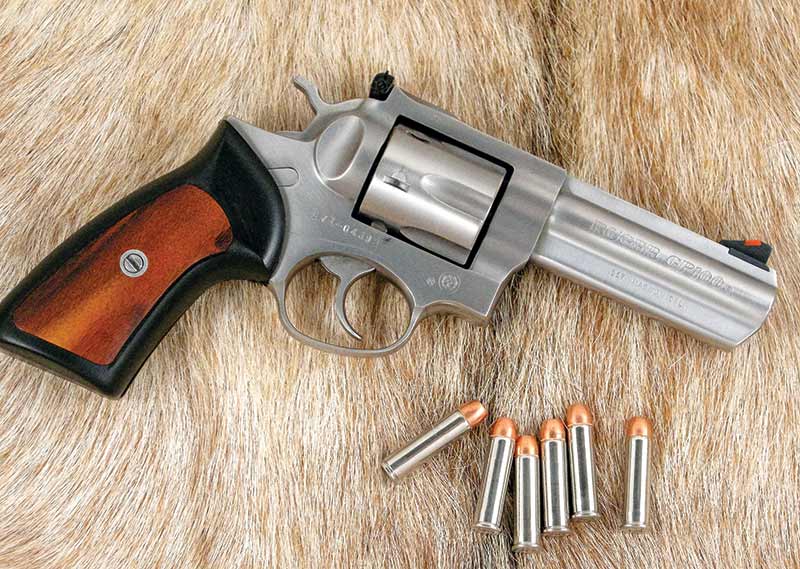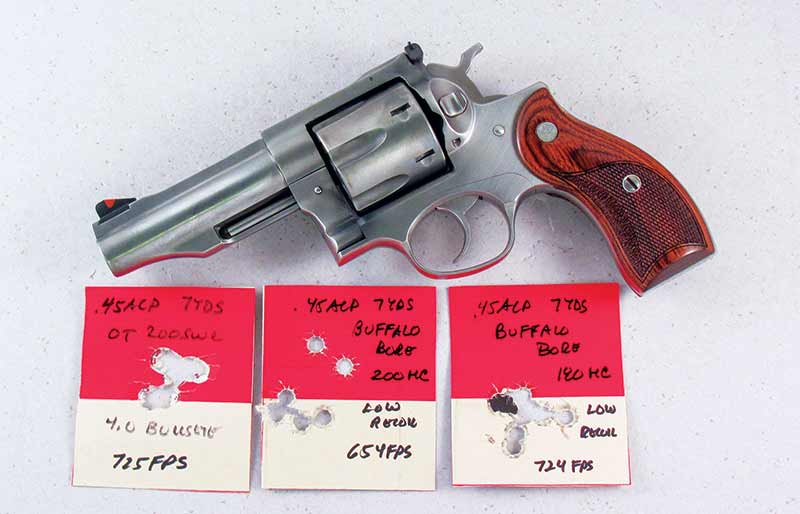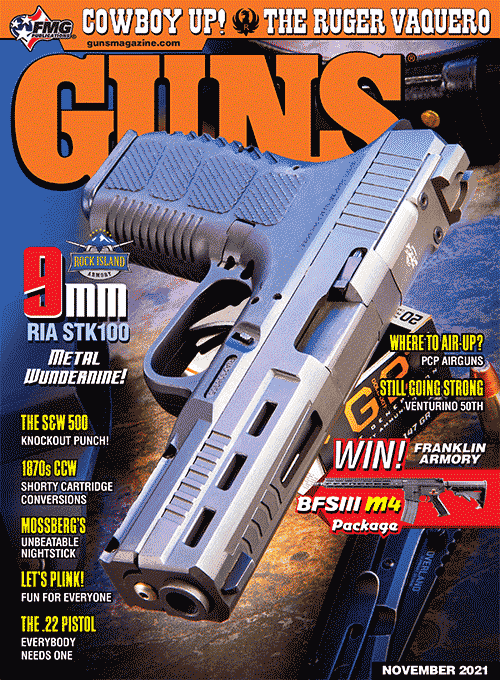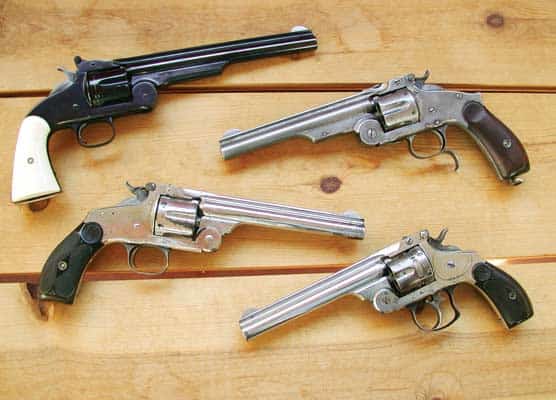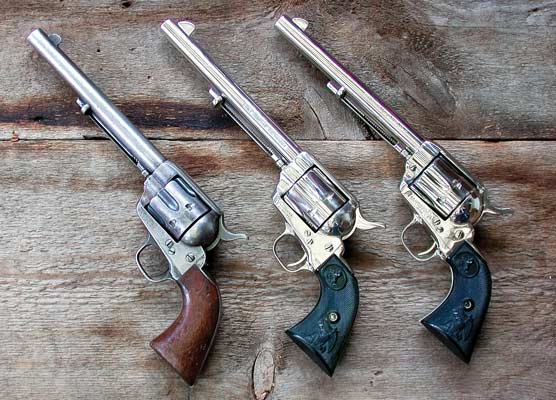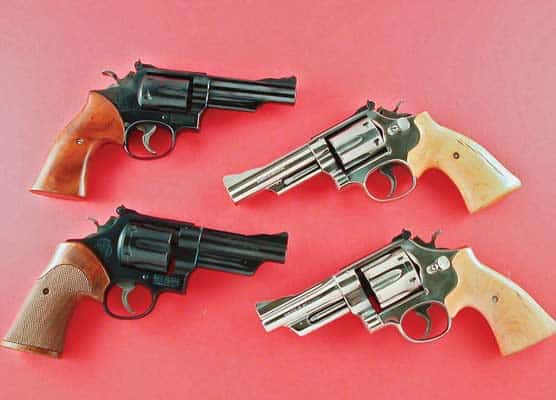Perfect Packin’ Pistol Part 8
Ruger: A Horse Of A Different Color
We have looked at 4″ Smith & Wesson double-action sixguns and now we finish up with a look at some other revolvers worthy of the title of Perfect Packin’ Pistol. Smith & Wesson has long been the King of Double-action Sixguns and always will be, at least in my sixgunnin’ heart. Elmer Keith, Skeeter Skelton and Bill Jordan all packed 4″ double-action Smith & Wesson sixguns. However, there are definitely some others to be considered.
Smith & Wesson sixguns have always been thoroughbreds, but there are other horses in the stable. One different type is the draft horse, and in the world of sixguns, this title goes to Ruger. Just as when we select a horse, the choice depends on what we expect from the horse. The thoroughbred is not better than the draft horse or vice versa, depending on what its job will be. When it comes to Ruger double-action sixguns, they are the exceptionally strong workhorses. If I was going to carry a double-action sixgun every day in any kind of weather where rough duty would be expected, I would choose a Ruger first.
For Starters
Ruger’s first entry into the double-action sixgun market came in 1971 with the Security-Six, which was soon followed by the Speed-Six and Service-Six. Suddenly Colt and Smith & Wesson faced real competition in the double-action market. By 1985 the Security-Six in all its variations — stainless steel and blued, chambered in .357 Magnum, .38 Special and 9 mm — had sold well over one million units.
Ruger literature for the Security-Six at the time proclaimed: “The first fundamental improvement in double-action revolver design in more than a half-century … Both reliable and durable, correctly designed and perfectly mated to the .357 Magnum cartridge, with the structural strength to withstand the firing of many thousands of rounds under the most rugged conditions.”
The Security-Six was popular with the public, however after more than one million units it was replaced by something even better — the GP100. The GP100 combined the locking system of the Redhawk with the no-tool takedown modular design of the Security-Six. When the Ruger engineers approached the new GP100, the grip frame was changed dramatically; it no longer existed. Instead Ruger incorporated what they called a “peg system” consisting of a steel stud that allowed the use of recoil-reducing soft rubber grips. These grips also have a built-in hump at the top of the backstrap to aid in controlling recoil especially in rapid-fire situations. Realizing grip feel is highly subjective I can say these grips, with a built-in thumb rest indentation on the top of the left panel, fit my hand very well and definitely reduce felt recoil.
The GP 100 also had a new trigger system which allowed a lighter pull than the Redhawk. The barrel was of the heavy-underlugged style on the 4″ version. A look at the GP100 from the top gives the impression of strength. The top strap is thick, heavy and flat while the barrel is not only underlugged, it’s also fitted with a heavy rib that is striated from the front of the frame to the back of the front sight. The front sight fits in a dovetail and is held in place by a spring plunger which enters from the front. This changeable front sight is mated with a Ruger square notch rear sight with a white outline which is click adjustable for both windage and elevation. The rear sight is protected by the frame “ears” on both sides, a feature first appearing on the Ruger Blackhawk in 1962.
Ruger also changed the cylinder lockup on their double-action sixguns as compared to the old line Colt and Smith & Wesson revolvers. Lockup is at the rear of the cylinder and with a latch at the front of the frame. The extractor rod is enclosed and protected by the heavy underlug. Colt and Smith & Wesson revolvers released their cylinder by pushing backward or forward respectively on the cylinder release on the left side of the frame while Ruger changed this to a button that is pushed in to release the cylinder. It works much easier for my thumb.
My nearly 40-year-old 4″ Ruger GP100 4″ Stainless Steel shoots exceptionally well with the Black Hills’ 158 JHP clocking out at 1,269 fps and the Speer 125 GDHP at 1,450 fps with both grouping five shots in 3/4″ at 20 yards. My favorite cast bullet load for standard weight bullets in the .357 Magnum, the Lyman/Thompson #358156GC over 14.0 grains of #2400 does 1,286 fps in the short-barreled GP grouping in 1-1/4″ while my gentle loading of Lyman’s #358477 over 7.0 grains of Universal groups in 1″ at just under 1,200 fps.
The Redhawk
Ruger’s first big-bore double-action sixgun — the Redhawk — debuted in 1979/1980 offered in .44 Magnum. Ruger had two great advantages over earlier double-action .44 Magnums, namely, introducing it at the time of greatest demand and building it around the cartridge rather than chambering some existing model for the .44 Magnum. The result was an exceptionally strong sixgun and this was accomplished without being overly heavy or clumsy. The strength of the Redhawk comes with the threaded area of the frame where it accepts the barrel being very thick, double what one finds in many other sixguns and also having the massive cylinder locked at the rear and front of the cylinder itself rather than at the end of the ejector rod. The heavy-ribbed barrel and equally heavy top strap both give a feeling of exceptional brute strength.
For some reason Ruger did not offer a 4″ .44 Magnum Redhawk so I made my own. Starting with a 5-1/2″ Redhawk, I had my local gunsmith cut the barrel to 4″, re-crown it, mount a black post front sight and slightly alter the grip frame, all resulting in a superb candidate easy to carry, powerful sixgun. This very simple customizing performed on the Redhawk included rounding the front and back corners of the bottom of the grip frame as well as the factory grips. With these custom touches, the Redhawk becomes a candidate for a Perfect Packin’ Pistol and will handle the heaviest .44 Magnum loads available, including those with heavy hard-cast bullets offered by Buffalo Bore, Cor-Bon and Garrett Cartridges. With its stainless steel construction and the fact it is built for strength and endurance, the Redhawk is an awfully good choice for the outdoorsman.
In 2007 Ruger saw the error of their ways and began offering a 4″ Redhawk in .44 Magnum, then followed up the next year with the same sixgun chambered in .45 Colt. Both of these feature finger-groove rubber grips are a great improvement over the original factory stocks and do much to minimize felt recoil of heavy loads. Then a few years ago, Ruger brought out a 4″ Convertible Redhawk. Ruger has a long history of convertible single-action sixguns with two cylinders. However, they took a different path with the Redhawk and came up with a way to fire both .45 Colt and .45 ACP rounds from the same cylinder. The latter requires moon clips and the system works quite well and certainly adds to the versatility of the Redhawk.
For someone who spends a lot of time outdoors in all kinds of weather and has a need for an easy packing, heavy-duty big bore sixgun, it would be hard to come up with one more rugged, ready and reliable than the 4″ Redhawk.


